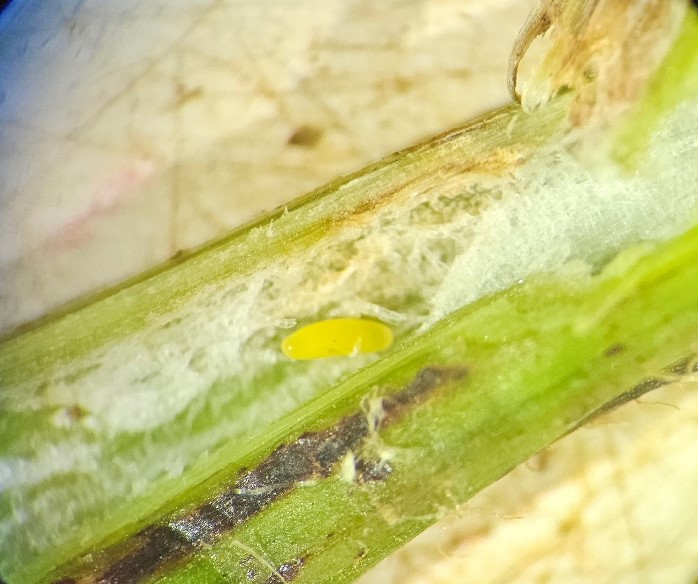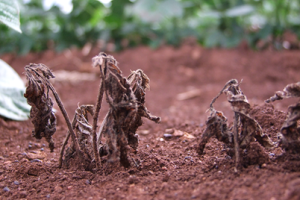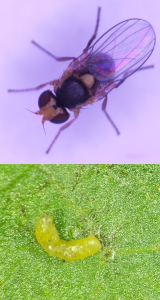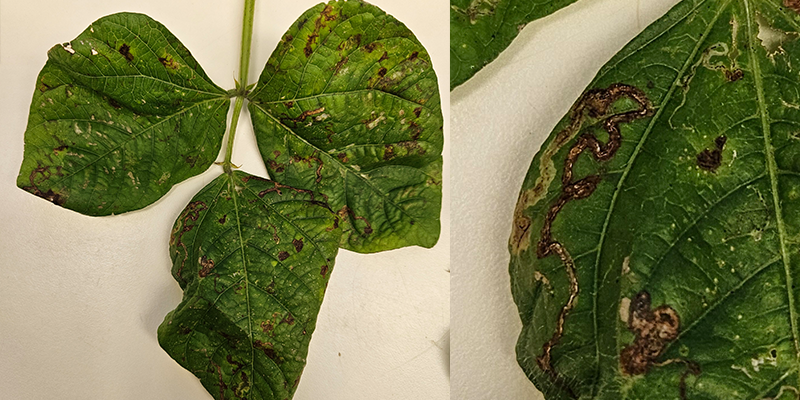As we approach the end of the mungbean season in southern Queensland, there have been several reports of pest fly infestations in mungbean crops, including bean fly (Ophiomyia phaseoli) attacking later stage crops, along with infestations of the relatively recent invader the American serpentine leaf miner (Liriomyza trifolii).
Late bean fly infestations
Late bean fly damage was recently observed in mungbean crops in the South Burnett. Bean fly damage is more common in coastal and tropical areas, where it is typically is a pest of seedling summer pulse crops, affecting mungbean, navy beans, and black gram (but not soybean). However, it is also not unusual to find infestations during later crop stages, particularly during high-rainfall seasons.
Female bean fly lay their eggs into leaves and the larvae tunnel through leaf tissue, through the petiole, eventually making their way into the plant stem. The damage caused by this feeding includes dead leaves and even plant death in seedling crops.

Bean fly pupa in a mungbean stem. Photo: Trevor Volp.
Management

Bean fly can cause the death of mungbean seedlings. Photo: Hugh Brier.
The most severe crop stage for bean fly infestations is during early vegetative crops, where plant death due to infestations can significantly impact plant populations. The threshold during the seedling stage is 1 larval tunnel per plant. In later vegetative and reproductive stages thresholds are based on leaf damage, with thresholds of 33% leaf damage for vegetative crops, decreasing to 20% leaf damage when plants are flowering, setting and filling pods.
Dimethoate is registered for use against bean fly in summer pulses. Always follow label instructions.
If infestations of bean fly are occurring during later podding stages, such as the ones we’ve recently observed, agronomists must decide whether fly tunnelling in leaves is still capable of causing yield loss. If crops are at the black pod stage, ready for desiccation, it is unlikely a bean fly infestation will affect yield.
It is also worth examining if the infestation is still active. If you are only able to find pupal casings and no bean fly larva remain in the plants, then spraying an insecticide will have no impact on the damage that has already been done.
American serpentine leaf miner

American serpentine leaf miner adult and larva. Photos: Trevor Volp.
In addition to the regular bean fly, in recent years we have seen several invasive leaf mining fly species arrive in Australia that put summer pulse production at risk. These include the American serpentine leaf miner (Liriomyza trifoli), the serpentine leaf miner (L. huidobrensis), and the vegetable leaf miner (L. sativae).
Recently QDPI entomologists have been made aware of American serpentine leaf miner infestations in mungbean on the Darling Downs. The larvae produce obvious mines through leaf tissue, and the damage symptoms are quite distinct from traditional bean fly damage.

American serpentine leaf miner damage symptoms, with a close-up of the mines on the right. Photos: Trevor Volp.
Again, these infestations were during later crop stages where the impact of leaf damage may be limited. There was also substantial parasitoid wasp activity associated with these infestations.
No research has yet been conducted on these exotic Liriomyza spp. pests in mungbean in Australia.
Management
Dimethoate was previously available under permit for the control of Liriomyza leaf miners under APVMA permit PER89184, however this permit lapsed in March 2025.
If growers or agronomists become aware of similar infestations, please alert QDPI entomologists.
For more information contact Trevor Volp (0429 641 912) or Melina Miles (0407 113 306)
Article by Trevor Volp & Melina Miles
